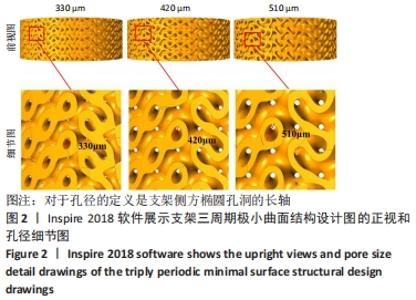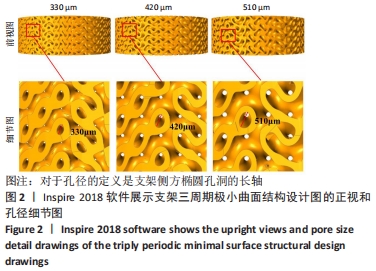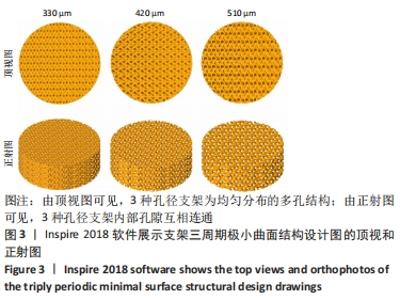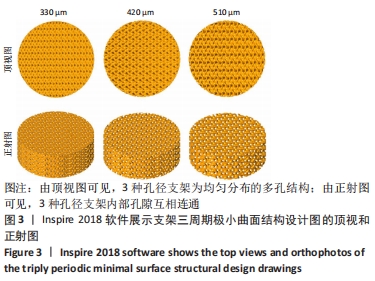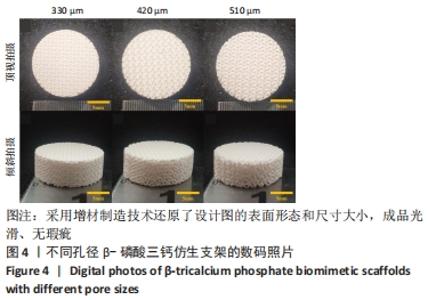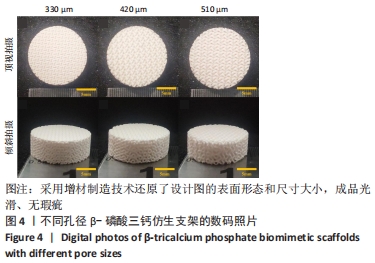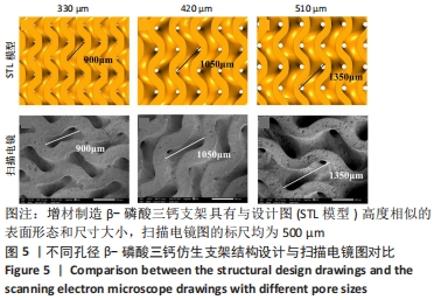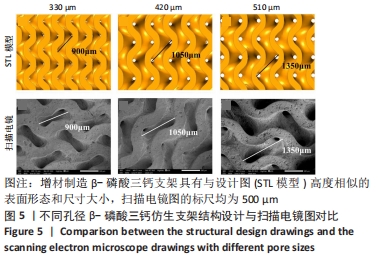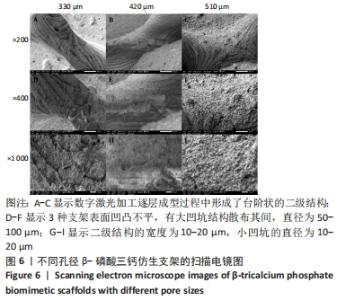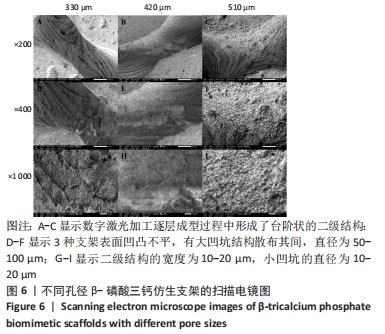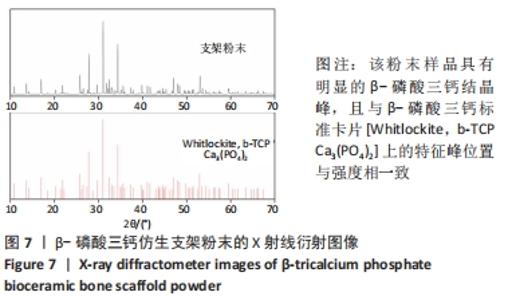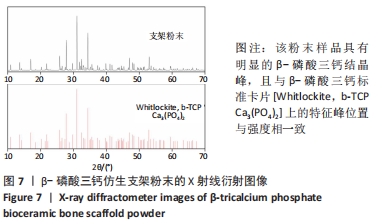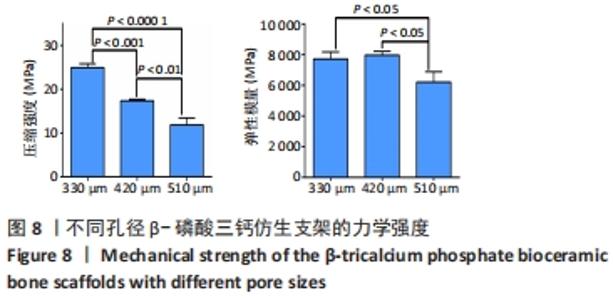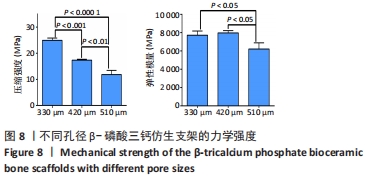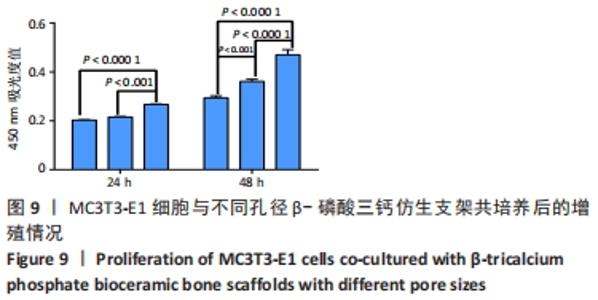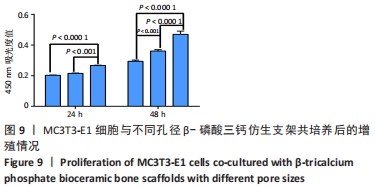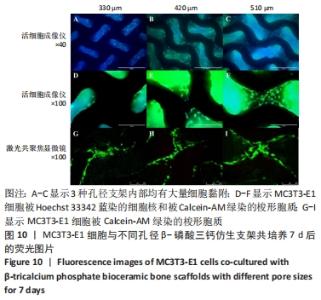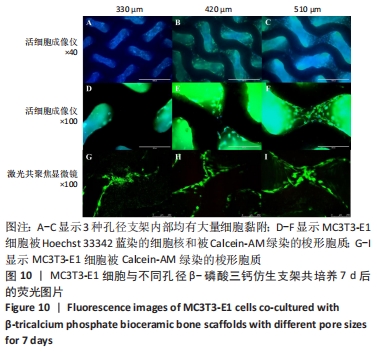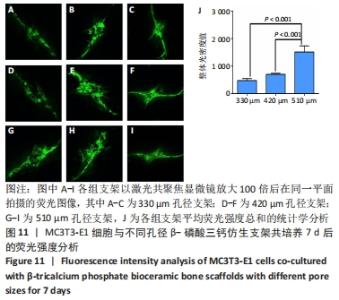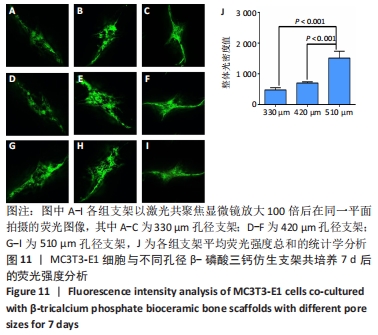Chinese Journal of Tissue Engineering Research ›› 2022, Vol. 26 ›› Issue (21): 3291-3297.doi: 10.12307/2022.634
Previous Articles Next Articles
Design and biological activity of beta-tricalcium phosphate biomimetic bone scaffold based on triply periodic minimal surfaces
Wang Jinsi1, Wang Shengfa2, Wu Zhuguo1, He Xiaoling1, Wang Xinyu2, Luo Xiaoyu1, Zhao Yi1, Zhang Jingying1
- 1Dongguan First Hospital Affiliated to Guangdong Medical University, Dongguan 523808, Guangdong Province, China; 2DUT-RU International School of Information and Software Engineering, Dalian University of Technology, Dalian 116620, Liaoning Province, China
-
Received:2021-06-28Accepted:2021-08-12Online:2022-07-28Published:2022-01-27 -
Contact:Zhang Jingying, MD, Associate professor, Dongguan First Hospital Affiliated to Guangdong Medical University, Dongguan 523808, Guangdong Province, China -
About author:Wang Jinsi, Master candidate, Dongguan First Hospital Affiliated to Guangdong Medical University, Dongguan 523808, Guangdong Province, China -
Supported by:the Basic and Applied Basic Research of Guangdong Province, No. 2020B1515120001 (to ZJY); Key Fields Foundation of Colleges and Universities in Guangdong Province, No. 2020ZDZX2013 (to ZJY); Discipline Construction Project of Guangdong Medical University, No. 4SG21019G (to ZJY); Discipline Construction Project of Guangdong Medical University, No. 4SG21015G (to WZG)
CLC Number:
Cite this article
Wang Jinsi, Wang Shengfa, Wu Zhuguo, He Xiaoling, Wang Xinyu, Luo Xiaoyu, Zhao Yi, Zhang Jingying. Design and biological activity of beta-tricalcium phosphate biomimetic bone scaffold based on triply periodic minimal surfaces[J]. Chinese Journal of Tissue Engineering Research, 2022, 26(21): 3291-3297.
share this article
Add to citation manager EndNote|Reference Manager|ProCite|BibTeX|RefWorks
| [1] LI L, LU H, ZHAO Y, et al. Functionalized cell-free scaffolds for bone defect repair inspired by self-healing of bone fractures: A review and new perspectives. Mater Sci Eng C Mater Biol Appl. 2019;98:1241-1251. [2] KELLY CN, LIN AS, LEGUINECHE KE, et al. Functional repair of critically sized femoral defects treated with bioinspired titanium gyroid-sheet scaffolds. J Mech Behav Biomed Mater. 2021;116:104380. [3] DEKKER TJ, STEELE JR, FEDERER AE, et al. Use of Patient-Specific 3D-Printed Titanium Implants for Complex Foot and Ankle Limb Salvage, Deformity Correction, and Arthrodesis Procedures. Foot Ankle Int. 2018;39(8):916-921. [4] LIU T, FANG W, WU G, et al. Low Dose BMP2-Doped Calcium Phosphate Graft Promotes Bone Defect Healing in a Large Animal Model. Front Cell Dev Biol. 2020; 8:613891. [5] MARINO JT, ZIRAN BH. Use of solid and cancellous autologous bone graft for fractures and nonunions. The Orthopedic clinics of North America. 2010;41(1): 15-26. [6] ZHAI P, PENG X, LI B, et al. The application of hyaluronic acid in bone regeneration. Int J Biol Macromol. 2020;151:1224-1239. [7] AMINI Z, LARI R. A systematic review of decellularized allograft and xenograft-derived scaffolds in bone tissue regeneration. Tissue Cell. 2021;69:101494. [8] COHEN DJ, SCOTT KM, KULKARNI AN, et al. Acellular mineralized allogenic block bone graft does not remodel during the 10 weeks following concurrent implant placement in a rabbit femoral model. Clin Oral Implants Res. 2020;31(1):37-48. [9] CAMPANA V, MILANO G, PAGANO E, et al. Bone substitutes in orthopaedic surgery: from basic science to clinical practice. J Mater Sci Mater Med. 2014; 25(10):2445-2461. [10] RODDY E, DEBAUN MR, DAOUD-GRAY A, et al. Treatment of critical-sized bone defects: clinical and tissue engineering perspectives. Eur J Orthop Surg Traumatol. 2018;28(3):351-362. [11] ZHOU H, YANG L, GBURECK U, et al. Monetite, an important calcium phosphate compound-Its synthesis, properties and applications in orthopedics. Acta Biomater. 2021;127:41-55. [12] YUAN B, WANG Z, ZHAO Y, et al. In Vitro and In Vivo Study of a Novel Nanoscale Demineralized Bone Matrix Coated PCL/β-TCP Scaffold for Bone Regeneration. Macromol Biosci. 2021;21(3):e2000336. [13] CHARBONNIER B, MANASSERO M, BOURGUIGNON M, et al. Custom-made macroporous bioceramic implants based on triply-periodic minimal surfaces for bone defects in load-bearing sites. Acta Biomater. 2020;109:254-266. [14] STASTNY P, SEDLACEK R, SUCHY T, et al. Structure degradation and strength changes of sintered calcium phosphate bone scaffolds with different phase structures during simulated biodegradation in vitro. Mater Sci Eng C Mater Biol Appl. 2019;100:544-553. [15] AL-KETAN O, LEE DW, ROWSHAN R, et al. Functionally graded and multi-morphology sheet TPMS lattices: Design, manufacturing, and mechanical properties. J Mech Behav Biomed Mater. 2020;102:103520. [16] KELLY CN, FRANCOVICH J, JULMI S, et al. Fatigue behavior of As-built selective laser melted titanium scaffolds with sheet-based gyroid microarchitecture for bone tissue engineering. Acta Biomater. 2019;94:610-626. [17] RAJAGOPALAN S, ROBB RA. Schwarz meets Schwann: design and fabrication of biomorphic and durataxic tissue engineering scaffolds. Med Image Anal. 2006; 10(5):693-712. [18] HE L, LIU X, RUDD C. Additive-Manufactured Gyroid Scaffolds of Magnesium Oxide, Phosphate Glass Fiber and Polylactic Acid Composite for Bone Tissue Engineering. Polymers (Basel). 2021;13(2):270. [19] PARÉ A, CHARBONNIER B, TOURNIER P, et al. Tailored Three-Dimensionally Printed Triply Periodic Calcium Phosphate Implants: A Preclinical Study for Craniofacial Bone Repair. ACS Biomater Sci Eng. 2020;6(1):553-563. [20] 贾涛.钛基层状多孔材料的制备及压缩力学性能研究[D].西安:西安理工大学,2020. [21] CHENG Q, HUANG C, TOMSIA AP. Freeze Casting for Assembling Bioinspired Structural Materials. Adv Mater. 2017;29(45). doi: 10.1002/adma.201703155. [22] KE Z, YANG L, WU H, et al. Evaluation of in vitro and in vivo antitumor effects of gambogic acid-loaded layer-by-layer self-assembled micelles. Int J Pharm. 2018; 545(1-2): 306-317. [23] YANG Y, LI X, CHU M, et al. Electrically assisted 3D printing of nacre-inspired structures with self-sensing capability. Sci Adv. 2019;5(4):eaau9490. [24] BARBER H, KELLY CN, NELSON K, et al. Compressive anisotropy of sheet and strut based porous Ti-6Al-4V scaffolds. J Mech Behav Biomed Mater. 2021;115:104243. [25] ALI D. Effect of scaffold architecture on cell seeding efficiency: A discrete phase model CFD analysis. Comput Biol Med. 2019;109:62-69. [26] ZANKOVIC S, SEIDENSTUECKER M, PRALL WC, et al. A Method for the Evaluation of Early Osseointegration of Implant Materials Ex Vivo: Human Bone Organ Model. Materials (Basel). 2021;14(11):3001. [27] LIU Y, YANG S, CAO L, et al. Facilitated vascularization and enhanced bone regeneration by manipulation hierarchical pore structure of scaffolds. Mater Sci Eng C Mater Biol Appl. 2020;110:110622. [28] FREEMAN FE, BROWE DC, NULTY J, et al. Biofabrication of multiscale bone extracellular matrix scaffolds for bone tissue engineering. Eur Cells Mater. 2019; 38:168-187. [29] OLADAPO BI, ZAHEDI SA, ISMAIL SO, et al. 3D printing of PEEK and its composite to increase biointerfaces as a biomedical material- A review. Colloids Surf B Biointerfaces. 2021;203:111726. [30] DAVOODI E, MONTAZERIAN H, ESMAEILIZADEH R, et al. Additively Manufactured Gradient Porous Ti-6Al-4V Hip Replacement Implants Embedded with Cell-Laden Gelatin Methacryloyl Hydrogels. ACS Appl Mater Interfaces. 2021;13(19):22110-22123. [31] MANZOOR F, GOLBANG A, JINDAL S, et al. 3D printed PEEK/HA composites for bone tissue engineering applications: Effect of material formulation on mechanical performance and bioactive potential. J Mech Behav Biomed Mater. 2021;121:104601. [32] 耿鹏.聚醚醚酮及其复合材料增材制造机理与实验研究[D].长春:吉林大学, 2019. [33] CHANG HY, TUAN WH, LAI PL. Biphasic ceramic bone graft with biphasic degradation rates. Mater Sci Eng C Mater Biol Appl. 2021;118:111421. [34] WANG C, LAI J, LI K, et al. Cryogenic 3D printing of dual-delivery scaffolds for improved bone regeneration with enhanced vascularization. Bioact Mater. 2021; 6(1):137-145. [35] ZHONG L, CHEN J, MA Z, et al. 3D printing of metal-organic framework incorporated porous scaffolds to promote osteogenic differentiation and bone regeneration. Nanoscale. 2020;12(48):24437-24449. [36] MELCHELS F PW, BARRADAS AMC, VAN BLITTERSWIJK CA, et al. Effects of the architecture of tissue engineering scaffolds on cell seeding and culturing. Acta Biomater. 2010;6(11):4208-4217. [37] HU J, WANG S, LI B, et al. Efficient Representation and Optimization for TPMS-Based Porous Structures. IEEE Trans Vis Comput Graph. 2020. doi: 10.1109/TVCG. 2020.3037697. [38] ZADPOOR AA. Mechanical performance of additively manufactured meta-biomaterials. Acta Biomater. 2019;85:41-59. [39] SANTOS J, PIRES T, GOUVEIA BP, et al. On the permeability of TPMS scaffolds. J Mech Behav Biomed Mater. 2020;110:103932. [40] MA S, SONG K, LAN J, et al. Biological and mechanical property analysis for designed heterogeneous porous scaffolds based on the refined TPMS. J Mech Behav Biomed Mater. 2020;107:103727. [41] HENKEL J, WOODRUFF MA, EPARI DR, et al. Bone Regeneration Based on Tissue Engineering Conceptions - A 21st Century Perspective. Bone Res. 2013;1(3):216-248. [42] 周丽超.基于三周期极小曲面的模型空间剖分研究[D].大连:大连理工大学, 2019. [43] HA M, ATHIRASALA A, TAHAYERI A, et al. Micropatterned hydrogels and cell alignment enhance the odontogenic potential of stem cells from apical papilla in-vitro. Dent Mater. 2020;36(1):88-96. [44] HAYASHI K, MUNAR ML, ISHIKAWA K. Effects of macropore size in carbonate apatite honeycomb scaffolds on bone regeneration. Mater Sci Eng C Mater Biol Appl. 2020;111:110848. [45] GUPTE MJ, SWANSON WB, HU J, et al. Pore size directs bone marrow stromal cell fate and tissue regeneration in nanofibrous macroporous scaffolds by mediating vascularization. Acta Biomater. 2018;82:1-11. [46] DIAO J, OUYANG J, DENG T, et al. 3D-Plotted Beta-Tricalcium Phosphate Scaffolds with Smaller Pore Sizes Improve In Vivo Bone Regeneration and Biomechanical Properties in a Critical-Sized Calvarial Defect Rat Model. Adv Healthc Mater. 2018; 7(17):e1800441. [47] LI L, SHI J, ZHANG K, et al. Early osteointegration evaluation of porous Ti6Al4V scaffolds designed based on triply periodic minimal surface models. J Orthop Translat. 2019;19:94-105. [48] 刁静静.磷酸钙生物活性陶瓷支架孔尺寸的精确调控及骨再生修复效果[D].广州:华南理工大学,2019. |
| [1] | Yang Sidi, Wang Qian, Xu Nuo, Wang Ronghan, Jin Chuanqi, Lu Ying, Dong Ming. Biodentine enhances the proliferation and differentiation of osteoblasts through upregulating bone morphogenetic protein-2 [J]. Chinese Journal of Tissue Engineering Research, 2022, 26(4): 516-520. |
| [2] | Wei Zhangao, Xu Linghan, Wu Zichen, Tang Hao, Chen Jialong. Application of inorganic nonmetallic artificial bone materials in vivo [J]. Chinese Journal of Tissue Engineering Research, 2022, 26(16): 2584-2589. |
| [3] | Liu Qingbo, Su Zhiyang, Wang Hengfeng, Zhao Yu, Lyu Jia. Biomechanical properties of trabecular bone prosthesis with triply periodic minimal surfaces unit structure [J]. Chinese Journal of Tissue Engineering Research, 2022, 26(15): 2297-2301. |
| [4] | Chai Le, Ding Xiao, Wang Bin, Chen Xu, Guo Jiarui, Zhu Guangpu, Yu Jinwei . Effect of platelet-rich plasma with bioceramic system on the treatment of ARCO stage II osteonecrosis of the femoral head [J]. Chinese Journal of Tissue Engineering Research, 2022, 26(15): 2347-2351. |
| [5] | Li Ruozhen, Tian Yaping, Wen Ning. Biological effect of magnetic fields to promote bone responses to biomaterials [J]. Chinese Journal of Tissue Engineering Research, 2021, 25(28): 4510-4515. |
| [6] | Zheng Feng, Zhang Fucai, Xu Zhe. MicroRNA-98-5p promotes osteoblast proliferation and differentiation: possibilities and mechanisms [J]. Chinese Journal of Tissue Engineering Research, 2021, 25(26): 4112-4117. |
| [7] | Zhou Wu, Wang Binping, Wang Yawen, Cheng Yanan, Huang Xieshan. Transforming growth factor beta combined with bone morphogenetic protein-2 induces the proliferation and differentiation of mouse MC3T3-E1 cells [J]. Chinese Journal of Tissue Engineering Research, 2021, 25(23): 3630-3635. |
| [8] | Li Xinping, Cui Qiuju, Zeng Shuguang, Ran Gaoying, Zhang Zhaoqiang, Liu Xianwen, Fang Wei, Xu Shuaimei. Effect of modification of β-tricalcium phosphate/chitosan hydrogel on growth and mineralization of dental pulp stem cells [J]. Chinese Journal of Tissue Engineering Research, 2021, 25(22): 3493-3499. |
| [9] | Liu Keke, Duan Xin, Ma Xiangrui, Zhang Yuntao. Effect of cinnamaldehyde on osteoblasts in high glucose environment with the electrospinning membrane as a carrier [J]. Chinese Journal of Tissue Engineering Research, 2021, 25(22): 3500-3504. |
| [10] | He Lin, Wu Xi, He Song, Yang Sen. Hydrophilicity and cell adhesion of hydroxyapatite bioceramics after the coating of polydopamine [J]. Chinese Journal of Tissue Engineering Research, 2021, 25(22): 3540-3544. |
| [11] | Pan Xuan, Zhao Meng, Zhang Xiumei, Zhao Jie, Zhai Yunkai. Research and application of biological three-dimensional printing technology in the field of precision medicine: analysis of Chinese and English literature [J]. Chinese Journal of Tissue Engineering Research, 2021, 25(21): 3382-3389. |
| [12] | Wang Qian, Li Lu, Shu Jingyuan, Dong Zhiheng, Jin Youshi, Wang Qingshan. Micro-morphology and phase of zirconia-based nano-hydroxyapatite functional gradient biomaterials [J]. Chinese Journal of Tissue Engineering Research, 2021, 25(10): 1517-1521. |
| [13] | Li Jinyu, Yu Xing, Jiang Junjie, Xu Lin, Zhao Xueqian, Sun Qi, Zheng Chenying, Bai Chunxiao, Liu Chuyin, Jia Yusong. Promoting effect of osteopractic total flavone combined with nano-bone materials on proliferation and differentiation of MC3T3-E1 cells [J]. Chinese Journal of Tissue Engineering Research, 2020, 24(7): 1030-1036. |
| [14] | Wang Wenhong, Li Yanjun, Cui Caiyun. Factors influencing differentiation of stem cells from the apical papilla into odontoblasts [J]. Chinese Journal of Tissue Engineering Research, 2020, 24(31): 5071-5078. |
| [15] | Yan Caiping, Chen Lu, Deng Changgong, Chen Qian, Jiang Ke, Yi Yuanyuan, Li Yuling. Beta-ecdysterone promotes in vitro proliferation and osteogenic differentiation of MC3T3-E1 cells [J]. Chinese Journal of Tissue Engineering Research, 2020, 24(29): 4605-4612. |
| Viewed | ||||||
|
Full text |
|
|||||
|
Abstract |
|
|||||
